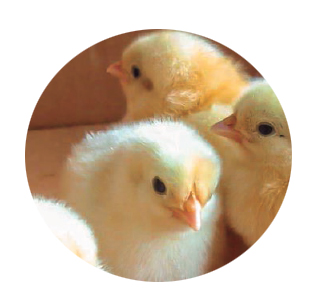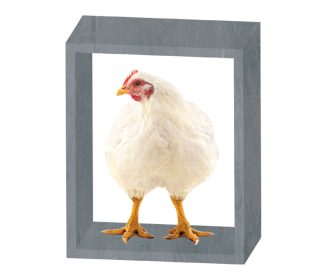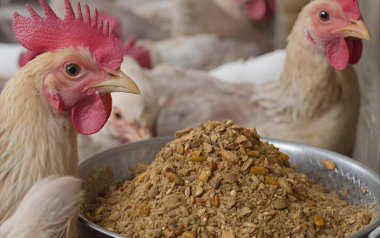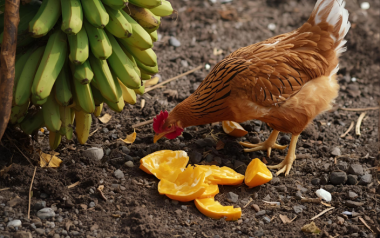30 Apr 2020
Poultry nutrition during the first and last week
Proper nutrition during a broiler's first and last weeks are extremely critical, as they can comprise up to 40% of the bird's life cycle.
Content available at:
Español (Spanish) Português (Portuguese (Brazil))
The genetic evolution of chickens brought some challenges to the specialists. Nutrition and food consumption are some of them because the life span of the animals in production has significantly decreased. The two phases under consideration in this article, involve the most important challenge of broiler production and may correspond to 30 or 40% of the total life of the animals.
First week
The chicks come out of an embryonic condition, where the energy base of their nutrition is the fat of the yolk and the protein of the albumin. Immediately after birth, the energetic base comes from starch, a nutritional component that never had contact during embryonic life, and the protein base of other proteins, which can have different digestibilities, depending on the sources. Additionally, in this phase, the base of the muscular structure is developed, which will be important for the eventual formation of the thighs. Because of all these initial limitations, the quality of the diet of the first week is fundamental.

The chicks must also learn to consume water quickly, to compensate for dehydration, which occurs from hatching until they reach the farm, and to encourage feed consumption and digestibility. In the first days of life, chicks do not have a developed thermoregulation system. Thus, in the condition of “poikilothermy”, they must stay in an environment with a very uniform temperature, so that they do not lose heat unduly.
There is a reasonable correlation between the 7-day body weight and slaughter weight. Thus, having good weight at 7 days is of significant importance in the final production of the flock. It is recommended, as a reference, that the chicks at 7 days are about 4.5 times the weight of the first day.
Chicks must LEARN to quickly consume feed and water
Last week
Normally, it is the week with the highest mortality. This is why in some conditions chickens are subjected to feed restriction. This period may vary from 5 to 7 days; With respect to food consumption. This can be due to:
- Sex
- Uniformity
- Temperature
- Density
This can hinder the correct administration of nutrients for this phase and also the handling of additives that require legal withdrawal periods. It is possible that on different days of the last week, chickens are removed from the house, causing periods of stress and withdrawal of feed (not recommended), in addition to increasing biosecurity risks. If chickens are separated by sex, all withdrawal schedules require different strategies. Furthermore, diets in this phase and in the previous phase may have different compositions and also require specific strategies for the amounts of feed and its distribution.
Nutrition in the first week
Food and water consumption
This is the first big challenge during a chick’s life in the first week. Here, the basic concerns are related to:
- Feed consumption
- Physical structure of food
- Water consumption.
The water:food ratio should be 2:1 from the first day of life. Feed consumption and its physical structure, together with water consumption, play an important role in the start of a chicks’ life, as they need water to consume food as they produce little saliva. It is said that “chickens eat, because they drink”. Chickens must have coarse particles at their disposal to see them easily and thus stimulate the beak mechanoreceptors, for greater consumption. From the first week of life, chicks prefer to eat coarse particles, when they are offered this possibility (Bueno, 2006).
Krabbe (2000) showed that the increase in the particles of the pre-initiation diet promoted an increase in the metabolizable energy of the diet as well as increased nitrogen and dry matter retention.

Dibner et al. (1988) demonstrated that chicks that were without food for 72 hours, had a significant reduction in the development of bursa of Fabricius. The lack of food consumption also compromises glycogen synthesis, which is essential for maintaining the brain activity of the chicks and their growth.
The amount of glycogen present in the chick from its embryonic life, does not allow it to have normal levels of this metabolite for more than a day. After this period, the chick’s apathy becomes significant (Best, 1966). Chickens that do not consume food in the first two days will have a lower breast percentage than those that do.
Quality of ingredients
Feed quality is another fundamental issue for the proper development of the chicks in the first week. Chicks come from a different condition in the embryonic phase, they depend on many environmental factors to begin acclimating to the new conditions. If they do not receive diets with highly digestible ingredients, a lower flock uniformity is observed. Knowing the quality of the ingredients is the first step for having an efficient diet for the first week. It is useless to have a theoretically well-formulated formula if the feed that reaches the chicks has nothing to do with the theory.
Vieira and Moran (1999) had already shown that a 24-hour delay in chick housing decreases weight gain and increases mortality. Halevy et al (2000) showed that chick fasting in the first two days of life compromises the development of satellite cells and future muscle cells. Moore et al (2005) also referred to the importance of leucine in the initial diet, as its metabolite, β-hidroxi β-metil butyrate, promoted weight gain in turkeys and also an increase in satellite cells and a consequent increase in breast muscle weight.
In general, the most widely available ingredients in America are:
- Corn
- Corn gluten meal
- Soybean flour
- Meat meal, such as macros that provide energy and protein from diets
Corn
With respect to CORN, more and more attention is being given that it must be as clean as possible (pre-cleaning processes are unavoidable) and that it is selected by density, using densimetric tables. These procedures improve the uniformity of the ingredient and significantly decrease the presence of mycotoxins. Silva et al. (2008) showed that denser corn has more energy than less less dense ones, for both younger and older animals. Denser corn has a lower presence of mycotoxins (aflatoxins, fumonisins, etc). and has higher energy yields.
Soybean meal
The same concern should be kept in mind with SOYBEAN MEAL. The higher the level of crude protein, the lower the level of crude fiber and the better the performance of chickens in the first days of life (Gerber et al, 2006). When soybean meal is of poor quality, the main symptom in the first week is the presence of dirty cloaca, which occurs because the digestibility of the ingredients is reduced, providing an increase in the speed of passage through the digestive tract (increased peristalsis). additionally, it favors the exchange of intestinal cells and alters the microbial composition of the digestive tract.
A dirty cloaca in the first week of life can be due to poor quality of fat used in the diet and/or the presence of non-starch polysaccharides (NSPs)
Meat meal
Concerning FAT, not only the is the quality important, but also the type of fat used in the pre-starter diet, because of all that it can cause in the intestine, previously described above. Wiseman and Salvador (1991) have demonstrated that young chicks digest saturated fats less efficiently than older chicks. Saturated fatty acids promote a decreased colipase activation and micelles formation, which are important in this period of the chicks’ life, when lipase activity is normally lower than in later periods. Maiorka et al (1997) demonstrated that chicks in the first week do not digest fat added to the diet, which was identified when it was observed that they did not respond with weight gain and feed conversion when fat (energy) in the diet was increased.
Water
WATER can be considered as an ingredient or nutrient. Its increased consumption promotes, in a linear way, the consumption of food which, in turn, promotes weight gain (Viola, Penz and Ribeiro, 2005). Close care in regards to quantity, quality and temperature of the water is fundamental for the good performance of the chicks in their first and consequent weeks of life. The same authors identified that the lack of water compromised the development of the duodenal villi.
Protein and amino acids
Protein and amino acids are key nutritional components in this phase of a chick’s life. Wijtten et al. (2012), compared diets containing highly digestible proteins (fish meal, potato protein and corn gluten) with soybean meal based diets, and observed better gains for chickens receiving the highly digestible diet. This difference was most noticeable in the first 4 and 7 days of age.
Fernandes et al. (2009) had already shown that an increase in lysine in the diets resulted in an increase in the weights of the breast muscle and that of the breast fillet; in addition to an increase in the thickness of the breast fillet, in 7-day old chicks.
Tesseraud et al (2011) identified that methionine has a special function in the first week of a chick’s life, which is the stimulation of gene activity in birds. In the form of its metabolites, glutamine and cysteine, they work as inhibitors of cellular oxidative processes. Mucin production is important to protect the host against the action of pathogens, digestive enzymes and chemicals, as well as to collaborate in the process of digestion and absorption of nutrients. Important amino acids in the synthesis of mucin, such as threonine, glycine + serine and pro cysteine, are fundamental in chicken diets (Horn et al., 2009 and Lehmann et al., 2009).
In 2010, Wijtten et al., Working with a diet containing a normal protein value and another with 30% more protein than the first, identified a greater development of the duodenum, accompanied by a greater weight gain in the first week of the chick’s life. This was observed for Cobb 500 and Ross 308 male chicks. Everaert et al. (2010) observed that diets with more protein favor the absorption of the yolk sac in the first week of life of the chicks, and 70% of the immune structure of the digestive tissues can be recognized by a better development of the birds’ immune system. .
Minerals
The relationship between calcium and phosphorus available from the diet of the first week is very important. They must respect the minimum levels of each of the minerals. Provimi Experimental Farm, The Netherlands (2011) showed that the ideal ratio is close to 2:1 in periods of 1 to 3 days and 1 to 17 days of age. In the first week, if the calcium level increases above 1%, while maintaining the 2:1 ratio with the available phosphorus, weight gain values decrease. Sodium is an important mineral in this production phase. Stevens et al (1984) demonstrated that the absorption of glucose and methionine after hatching may be related to a deficiency of sodium, a mineral that is part of the carbohydrate and amino acid transport mechanism.
Practical evidence confirms Stevens et al ‘s (1984) observation, that marginal sodium deficiencies at this age are accompanied by weight loss, increased feed conversion and a lowered flock uniformity.
Maiorka et al (1998) and Vieira et al (2003) demonstrated the importance of sodium supplementation in pre-starter diets and how the humidity of chicken excrement and carcasses behaved. The data shows that in this specific phase, increasing the sodium value in the diet improves the performance of the chickens without compromising the humidity of the excreta and the carcasses. It was also possible to identify the importance of the ratio of sodium chloride and sodium bicarbonate in the first week of life. The best relationship between these two sources of sodium was 63% sodium chloride, for a diet that had 0.21% as total sodium (Provimi Brasil, 2009).
Nutrition in the last week
The last week is very challenging for nutritionists to adjust the nutritional needs of chickens. Some important parameters should be considered before formulating the diet for the last week, such as:
- Slaughter age of birds (28, 35, 42 or 49 days)
- Birds separated by sex or mixed and with differentiated feeding
- Ways of feeding chickens in this phase (“ad libitum” or even dietary restrictions made by light regime)
- Food availability by defined quantity per day or by more-or-less intense food withdrawal
- Purpose of the chickens produced (sale as live or as a product to be used in the transformation processes of the carcasses).
Chicken tissues have different allometric growths: the breast has a larger value (1.26) than the thighs (1.06), a difference present in later stages of development (Govaerts et al., 2000 and Schmidt et al ., 2009 ), the demand for amino acids being different and according to the final purpose of production.
Companies must have nutritional programs adapted to the slaughter dates. In general, diets that increase energy decrease nutrients and maintain or increase the relationships of digestible amino acids with digestible lysine.
In the production of sexed chickens, it is essential to consider different diets for all phases, especially after 21 days of age. Male and female formulations have price differences that can reach 3% minimum price weighted values, including the final product decision. In the formulation of sales of live chickens, the requirements are different from those required for chickens that will be bred, where the differences in the cost of formulation are significant. The most complex in the last week are dietary restrictions. Chickens consume amounts of nutrients with daily increase. The references in calories or percentage of nutrients in the diets are those that accommodate the adequate consumption for each day, as there is a daily increase in total food consumption.
When there are restrictions, either the density of the nutrients must be increased to compensate for the reductions in consumption or the chickens will have access to fewer nutrients each day (which in turn leads to marginal supplementation of all the additives, reducing their growth rate. Normally, the second situation is the most common, as the idea is to reduce the speed of consumption, for some metabolic reason and leading to an increase in mortality
Energy
Considering the cost of energy, various studies have been carried out to identify its effects on the performance of males and females in the final stages of production, where feed consumption is highly representative. Dozier III et al .. (2011), working with Ross x Ross 708 males and females, in the period of 36 to 47 days, using an EMAn amplitude of 3140 to 3240 kcal/kg, carried out two experiments. In experiment 1, independent of sex, the energy increase had a quadratic effect for weight gain and energy consumption and a linear effect for feed consumption, feed conversion and calorie conversion.
A better response by males to increases in metabolizable energy is explained with some clarity, since at this age the differences in daily gain between the two sexes are significant, where males need more energy to continue with higher gains than females.
Proteins and amino acids
Rostagno et al. (2007), presented work from their research group (Paéz, 2007) in which they worked with growth models and paid special attention to the requirements of digestible lysine in diets. Lysine reduction promoted increased abdominal fat deposition. However, the authors did not identify that reducing dietary protein compromised the performance of chicken breast, but did allow for an increase in abdominal fat. Corzo et al. (2006), working with 42- to 56-day-old Hubbard Ultra Yield males and females, evaluated total lysine requirements, using a range of 0.68 to 1.10% of this amino acid.
The authors found quadratic responses for carcass yield (0.88%), fillet yield (0.93%), and total breast yield (0.93). Thus, with the obtained values, the authors concluded that high-performance males need 0.93% total lysine, which; according to them, represents 0.85% digestible lysine.
Dozier III et al (2008), evaluated the requirement of digestible lysine for males and females Ross x Ross 708, over a period of 49 to 63 days of age. In this work, the authors, similar to the work done by Corzo et al (2006) also identified a difference between the sexes, for the requirement of digestible lysine. The requirements for males were 0.87%, for growth and 0.90% for breast yield. For females, the requirement for growth was 0.81%.
Dozier et al (2010), were also able to identify differences between high performance genetic lines. The authors worked with Ross x Ross TO16 and Cobb x Cobb 700, 28 to 42 days old. For weight gain, the Ross and Cobb chickens presented requirements of 0.988% and 0.965%, for feed conversion 1,053% and 1,012%, for carcass weight 0.939% and 1,029% and for breast weight 0.962% and 0.987%, respectively . In 1999, Kidd et al., Still working with total amino acid requirements, defined the importance of threonine in weight gain, feed conversion, and the breast growth of Ross x Hubbard males in the 42 to 56 day age period. The response was quadratic for these three parameters and in the end, the recommendation was 0.67%, for total threonine.
The authors commented that this would correspond to 0.60% of digestible threonine and that its ratio with digestible lysine should be 70%. Mejia et al. (2012) evaluated the digestible lysine:digestible arginine ratio of diets for Ross x Ross 708 males, in the period of 21 to 42 days, under high temperature environment. The authors concluded that the best response is 110% for feed conversion, even though the values between 105 and 120 did not show statistically different results. No differences were found for food consumption, weight gain, and mortality, as well as for carcass yield and for breast and abdominal fat. Mejia et al. (2011) showed that Ross x Ross 708 males, in a period of 28 to 42 days of age, have a digestible Ile:digestible Lys ratio requirement of 68.9% for performance and 71.7% for breast yield.
Minerals
Dandu and Angel (2003) demonstrated the importance of assessing phosphorus (P) requirements, especially in the final stages of chicken production, considering that they represent 45 to 65% of total animal consumption. Normally, P is expressed as total P (tP), available phosphorus (dP) and non-phytic phosphorus (nPP). The first represents, as the word says, the total of P obtained by analysis. Available phosphorus refers to the part of the total P that is used by the animal. However, non-phytic P is phosphorus that is not associated with inositol, and for this reason it is non-phytic and its value is obtained by the difference between the analysed values of tP and phytic P. In the experiment that worked with Ross 308 male chickens, in the period from 42 to 49 days of age, the authors identified the requirement of 0.16% of nPP, where the calcium level was 0.72%.
The authors defended this way of determining phosphorous since it is closer to the real need of the animal, being their most precise recommendation, eliminating a possible excess of supplementation of this mineral. Rousseau et al (2012) also managed to demonstrate, working with Ross PM3 chickens, aged between 21 and 38 days, that it is possible to formulate diets with a lower level of nPP than those commonly used. The authors reinforced that it is necessary to reconcile the level of nPP with that of calcium and with phytase, if it is being added to the diet. The main effects were observed in the bone characteristics of the animals and not in their performance.
Feed restriction
As we have previously commented, the feed restriction in the last stages of chicken production requires a case-by-case evaluation, from when the restriction begins, how it is applied and its intensity. The two main reasons for applying the restriction is to decrease end-of-production metabolic problems (ascites, sudden death, leg problems, etc.), which result in higher mortality, or to seek better feed conversion for the flock. The risk, when improperly managed, is that the flock has a reduction in weight gain and worse feed conversion, staying longer in the house to reach the weight and having the uniformity of the flock compromised .
Cornejo et al (2007) made qualitative restriction in Hubbard chickens, by decreasing metabolizable energy levels and increasing levels of crude protein in the diet. This was done with the purpose of reducing the energy: protein ratio of the diet. The birds were divided into 4 groups, a control group, fed ad libitum and three other groups with feeding restriction from 7 to 14, from 7 to 21 and from 22 to 35 days of age. The cumulative weight gain (1 to 49 days old) of the chickens in the control group was statistically higher than that of any of the restrictions. Considering only the 21 to 35 day restriction, this did not significantly affect feed consumption but altered the weight gain and feed conversion of chickens.
Once a restriction was promoted, and later feed was offered at will, the consumption increases but there is no time to compensate for the losses that occurred during the restriction period.
First week
In the first week, the chicken is prepared for its maximum future development. Any gain restriction in this phase will compromise the final performance of the animal. In the first week, all digestion and absorption structures are developed, allowing a better use of nutrients in the following phases.
Last phase
When we think about the last phase, this is very complex because before establishing any nutritional program it is essential to define: The slaughter age of chickens, if they are to be raised separated by sex or not or if feeding restrictions are promoted in this period. All these variables have to be taken into consideration at the time of formulation.




































